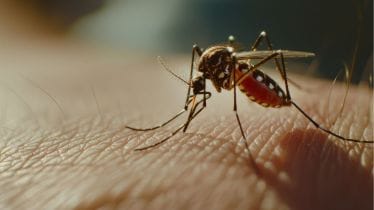China’s Guangdong province is battling a surge in chikungunya cases, with more than 7,000 infections reported since July. The city of Foshan has emerged as the epicentre of the outbreak, forcing authorities to impose strict containment measures.
Hospitals in the province have been instructed to keep infected patients in isolation, with beds covered under mosquito nets to prevent further spread. According to local health officials, patients are only discharged after at least a week of treatment or once they test negative for the virus. These steps are similar to the strict rules used during COVID-19, as authorities are trying to stop the mosquito-borne infection from spreading further.
A rare virus in China
Chikungunya, though common in South and Southeast Asia as well as parts of Africa, is considered rare in China. Experts believe the outbreak in Guangdong can be traced back to imported cases that spread rapidly in the hot and humid conditions following heavy monsoon rains. Floods and stagnant water have created ideal breeding grounds for Aedes aegypti and Aedes albopictus mosquitoes, the same species that spread dengue and Zika.
According to the World Health Organization (WHO), chikungunya outbreaks are often linked to sudden surges in mosquito populations after heavy rains or flooding. The virus is not transmitted from person to person, but spreads quickly when mosquito control measures are insufficient.
First warning signs of chikungunya
Health experts are urging the public to watch out for early symptoms. The US Centers for Disease Control and Prevention (CDC) lists the following as the most common signs of chikungunya:
- High fever (often sudden in onset)
- Severe joint pain, which may be debilitating
- Headache and muscle pain
- Skin rash
- Fatigue
In most cases, symptoms appear 3–7 days after being bitten by an infected mosquito. While chikungunya is rarely fatal, the joint pain can last for weeks or even months, significantly affecting quality of life. WHO warns that infants, elderly people, and those with pre-existing conditions like diabetes or heart disease are more likely to develop complications.
Preventive measures taken by authorities
Vice Premier Liu Guozhong has called for an ‘all-out’ response in Guangdong. The province has launched aggressive mosquito-control drives, including spraying, community clean-ups, and even the use of larva-eating fish in stagnant ponds. According to Chinese state media, drones are being deployed to spot hidden mosquito breeding grounds in hard-to-reach areas.
Hospitals in Foshan and surrounding cities have added more isolation wards. Local health departments are urging residents to cover water containers, use insect repellents, and wear long-sleeved clothing to minimise mosquito bites.
Global health bodies issue alert
The WHO has said it is closely monitoring the situation, while urging countries in Asia to strengthen mosquito surveillance and share outbreak data. The CDC has also updated its travel advisory for South China, asking visitors to take precautions such as using mosquito repellents containing DEET or picaridin.
Public health experts warn that climate change is making outbreaks like these more frequent. Rising temperatures, heavy monsoons, and urban flooding create ideal breeding conditions for mosquitoes. “This outbreak in Guangdong is a reminder that mosquito-borne viruses once considered rare in China can quickly escalate into major public health threats,” said a WHO spokesperson in a recent briefing.
As China works to contain the outbreak, doctors are urging people not to ignore the first signs of chikungunya. Early detection, along with mosquito control, remains the most effective way to prevent the disease from spreading further.
